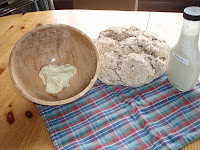Note from Cindy: If you have a way to drink kefir, we would all appreciate your sharing of that information. Jamie has added a cool way to drink it, but if you can make a comment with your recipe, it would be great. Maybe Apryle will share her smoothie recipe that she used it in. It is yummy. I don't want to say kefir is gross, just a really new flavor and texture. Any helpful tips are appreciated. I changed the settings so you can do an anonymous log in and post. If anyone leaves something weird, I will just delete it.... but why would they :) I can then gather them into a top ten ways to add kefir to your life or something like that.
My kefir grains arrived by mail, sealed in a double plastic bag and shipped in a plastic bubble envelope. Not very impressive are they? These grains were shipped with a little milk added to feed them during their trip and when you first open the sealed bags you'll notice a sour, yeasty odor, don't panic, that's normal.
The first thing you want to do is clean your grains. This is really easy. First take a sieve and dump them in, if you have trouble getting them out of the bag just pour a little milk in to loosen things up. After you've gotten the little grains out of the bag you want to pour a little milk or distilled water over them while gently shaking the sieve.
This is what they look like once they're all cleaned up.
Now you simply dump them into a clean jar, the one shown is quart size.
Another picture of the clean grains.
Here you'll see that I've added two cups of whole milk. Ideally you would want to use raw milk, but since it's unavailable in my area I've used organic whole milk instead.
You want to cover the jar with a cloth, you can't seal it up tight, kefir needs to breathe. Notice my high-tech dishcloth and rubber band combo, it worked great!
Kefir actually likes to be disturbed so I would give the jar a little shake everytime I walked through the kitchen. It's quite cool in my house so it took almost two whole days for my first batch to culture.
Here it is, almost two days later, ready to strain. Notice the streaking on the jar.
It will be quite thick at first, you'll think you messed up. You didn't.
You'll need your sieve, large bowl or measuring cup and a wooden spoon now. Place the sieve over the bowl, dump in the cultured kefir and you might have to stir gently with the wooden spoon but eventually all the kefir will strain through leaving only the grains, which have multiplied! Wow, busy little critters.
Here is the strained kefir, lousy picture, I know.
Here are the kefir grains that have increased in numbers by almost half!!
Here is my second batch of kefir set up and ready to culture again.
The finished product! If you haven't followed the baby steps to cultured foods I would recommend you start slow, just a couple tablespoons at first. For a great breakfast drink blend one cup chilled kefir with blueberries and some honey, it's wonderful!






















